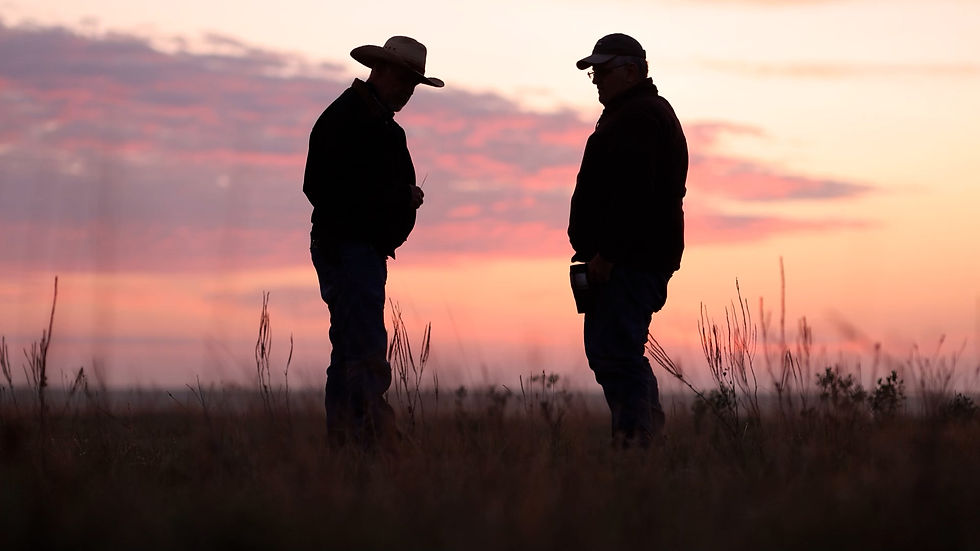Do Cows Eat More Than Grass? What Ranchers Are Learning About Weeds and Forbs
- mtsausen
- Aug 11
- 3 min read

In a short clip taken from the recent SD Grasslands Amazing Grasslands video, we shared Mike McKernan, SDSU’s Pete Bauman, Madison Kovarna, and Josh Lefer’s work clipping and testing dozens of native forbs and grasses to study their nutritional value throughout the season. That video triggered a flood of thoughtful—and skeptical—comments. One in particular stuck with me:
"Lots of plants are nutrient dense but it doesn’t mean anything if [they’re] not palatable to livestock."
This raises an important point—but maybe not in the way the commenter intended. It reflects a lingering assumption that livestock, especially cattle, are essentially grass-eating machines. And if that’s the worldview we start with, then sure, sampling 30 different plants might sound irrelevant. But what if we’re missing something bigger?
Cattle Eat More Than Grass
Let’s start here: cattle don’t just eat grass. Pete Bauman says it flatly in the video: "The assumption that they're only eating grass is really a falsehood." The South Dakota Grassland Coalition has been working with researchers and ranchers to understand the nutritional contribution of non-grass species. The results are eye-opening. Pete and Mike tested goldenrod and found protein levels rivaling dairy-grade alfalfa. The same was true for native thistles.
Cattle select plants, often taking a bite or two off goldenrod, for example, without visibly damaging the plant. This is targeted, strategic grazing behavior. It may not be obvious, but it matters.
Provenza and the Wisdom of the Herd
This is where Dr. Fred Provenza’s work becomes essential. Provenza, an animal behaviorist and author of the book Nourishment, has spent a career studying how livestock learn what to eat. In his research with rumen-cannulated animals, some cattle on diverse pastures had up to 60 species in their rumens. That’s not just about calories. That’s about medicine.
Provenza argues that animals use plant diversity not just to meet nutritional needs but to regulate their health. Different compounds in different plants help buffer digestion, balance energy, manage parasites, and support mineral needs. This isn’t fiction; it’s ecology.
Rethinking Palatability
Palatability isn’t fixed. Pete Bauman and Kathy Voth co-authored a valuable guide called Cows Eat Weeds, which walks producers through practical steps to help animals learn to eat plants once thought unpalatable or toxic. It turns out, animals are excellent learners—if given the chance.
The bigger question is: Are we managing in a way that allows animals to express their full potential? Or are we limiting their choices to a narrow slice of what the pasture could provide?
Bottom Line
There’s a growing body of evidence—from South Dakota to Utah to Texas—that livestock are capable of complex foraging strategies. Sampling 30 species, as McKernan, Lefers, and others are doing, isn’t about just proving plants are nutritious. It’s about understanding the full buffet nature offers. And when animals can access that buffet, they get healthier. Inputs go down. Profit potential goes up.
It might be time to retire the idea that grass is all they need.

Further Reading:
Nourishment by Fred Provenza
Plan Now to Control Weeds by Grazing Next Season (Pete Bauman)
Our Podcast Series with Dr. Fred Provenza Podcasts:
Visit these “Growing Resilience Through Our Soils” information pages:
1. Podcast page for drought planning fact sheets, Q&As, news, podcasts, and more.
2. Video page to watch videos of other ranchers’ journeys toward improved rangeland/pasture.
3. Follow Growing Resilience on social media:
4. Our homepage: www.growingresiliencesd.com





Comments